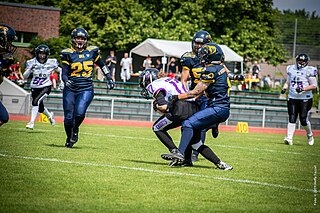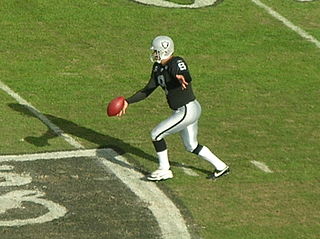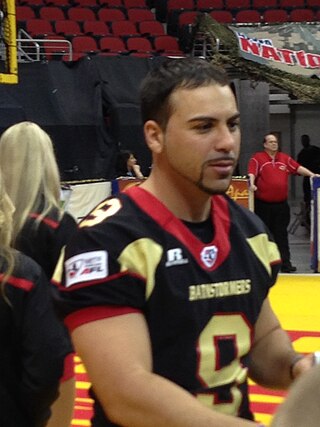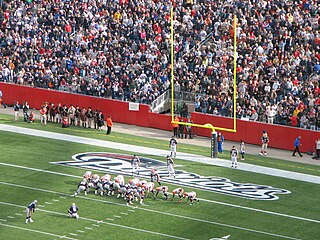Related Research Articles

Canadian football, or simply football, is a sport in Canada in which two teams of 12 players each compete on a field 110 yards (101 m) long and 65 yards (59 m) wide, attempting to advance a pointed oval-shaped ball into the opposing team's end zone.
A drop kick is a type of kick in various codes of football. It involves a player intentionally dropping the ball and then kicking it either 'as it rises from the first bounce' (rugby) or 'as, or immediately after, it touches the ground'.

A down is a period in which a play transpires in gridiron football. The down is a distinguishing characteristic of the game compared to other codes of football but is synonymous with the 6 "tackle" rule in rugby league. The team in possession of the football has a limited number of downs to advance ten yards or more towards their opponent's goal line. If they fail to advance that far, possession of the ball is turned over to the other team. In most situations if a team reaches their final down, they will punt to their opponent, which forces their opponent to begin their drive from further down the field; if they are in range, they might instead attempt to score a field goal.
In American football, a touchback is a ruling that is made and signaled by an official when the ball becomes dead on or behind a team's own goal line and the opposing team gave the ball the momentum, or impetus, to travel over or across the goal line but did not have possession of the ball when it became dead. Since the 2018 season, touchbacks have also been awarded in college football on kickoffs that end in a fair catch by the receiving team between its own 25-yard line and goal line. In the 2023 season, the NFL adopted the same rules as college football in regards to awarding touchbacks on kickoffs that end in a fair catch. In 2024, the NFL moved the placement of the ball after a touchback on a kickoff to the receiving team's 30-yard line; this was part of a radical change to the league's kickoff procedure. Such impetus may be imparted by a kick, pass, fumble, or in certain instances by batting the ball. A touchback is not a play, but a result of events that may occur during a play. A touchback is the opposite of a safety with regard to impetus since a safety is scored when the ball becomes dead in a team's end zone after that team — the team whose end zone it is — caused the ball to cross the goal line.

American and Canadian football are gridiron codes of football that are very similar; both have their origins partly in rugby football, but some key differences exist between the two codes.
In gridiron football, a quick kick is any punt made under conditions in which the opposing team would not expect a punt. Typically this has been a kick from scrimmage from a formation that is, or resembles, one usually used other than for punting, or at least not resembling the one usually used for punting. Typically it will also be on some down before last down, unless done from a formation usually used for place kicking.

The Music City Miracle was an American football play that took place on January 8, 2000, during the National Football League's (NFL) 1999–2000 playoffs. It occurred at the end of the American Football Conference (AFC) Wild Card playoff game between the Tennessee Titans and Buffalo Bills at Adelphia Coliseum in Nashville, Tennessee. After the Bills had taken a 16–15 lead on a field goal with 16 seconds remaining in the game, on the ensuing kickoff return, Titans tight end Frank Wycheck threw a lateral pass across the field to Kevin Dyson, who then ran 75 yards to score the winning touchdown to earn a 22–16 victory.

Gameplay in American football consists of a series of downs, individual plays of short duration, outside of which the ball is or is not in play. These can be plays from scrimmage – passes, runs, punts or field goal attempts – or free kicks such as kickoffs and fair catch kicks. Substitutions can be made between downs, which allows for a great deal of specialization as coaches choose the players best suited for each particular situation. During a play, each team should have no more than 11 players on the field, and each of them has specific tasks assigned for that specific play.

A punter (P) in gridiron football is a special teams player who receives the snapped ball directly from the line of scrimmage and then punts (kicks) the football to the opposing team so as to limit any field position advantage. This generally happens on a fourth down in American football and a third down in Canadian football. Punters may also occasionally take part in fake punts in those same situations, when they throw or run the football instead of punting.
Russell Erxleben is a former American football player and currency investor. He shares the record for the longest successful field goal in NCAA history at 67 yards, which he set in 1977 while playing for the University of Texas. Erxleben was a three-time All-American punter. He was drafted in the first round of the NFL Draft, an extremely rare occurrence for a kicker. After an NFL career lasting six years, he became a currency investor. Convicted of securities fraud in 1999, he was released from federal prison in 2005. He was again convicted of investment fraud in 2014 and sentenced to 90 months in federal prison.

In gridiron football, the holder is the player who receives the snap from the long snapper during field goal or extra point attempts made by the placekicker. The holder is set on one knee seven yards behind the line-of-scrimmage. Before the play begins, he places the hand which is closest to the placekicker on the ground in a location designated by the kicker's foot, with his forward hand ready to receive the snap. After receiving the snap, the holder will place the football on the turf, or block, ideally with the laces facing the uprights and the ball accurately placed where the backhand was initially, then balancing the ball with one or two fingers until the ball is kicked.

A comparison of American football and rugby union is possible because of the games' shared origins, despite their dissimilarities.

A field goal (FG) is a means of scoring in gridiron football. To score a field goal, the team in possession of the ball must place kick, or drop kick, the ball through the goal, i.e., between the uprights and over the crossbar. The entire ball must pass through the vertical plane of the goal, which is the area above the crossbar and between the uprights or, if above the uprights, between their outside edges. American football requires that a field goal must only come during a play from scrimmage while Canadian football retains open field kicks and thus field goals may be scored at any time from anywhere on the field and by any player. The vast majority of field goals, in both codes, are placekicked. Drop-kicked field goals were common in the early days of gridiron football but are almost never attempted in modern times. A field goal may also be scored through a fair catch kick, but this is also extremely rare. In most leagues, a successful field goal awards three points.

The place kick is a type of kicking play commonly used in American football, association football (soccer), Canadian football, rugby league, and rugby union. It was historically used in Australian rules football, but it was phased out of the game more than 100 years ago.
The 2001 San Diego Chargers season was the franchise's 32nd season in the National Football League (NFL) and the 42nd overall and the third and final season under head coach Mike Riley. The team improved on their 1–15 record in 2000 to finish 5–11 but missed the playoffs for the 6th straight year. It was Mike Riley's final season as the team's head coach. At the end of the season running back LaDainian Tomlinson won the Offensive Rookie of the Year award. Despite finishing 5–11 after losing their final nine games of the season, eight of the Chargers' losses were by less than a touchdown, five of them were by three points, and three of them were by ten points.
The following terms are used in American football, both conventional and indoor. Some of these terms are also in use in Canadian football; for a list of terms unique to that code, see Glossary of Canadian football.

In gridiron football, a punt is a kick performed by dropping the ball from the hands and then kicking the ball before it hits the ground. The most common use of this tactic is to punt the ball downfield to the opposing team, usually on the final down, with the hope of giving the receiving team a field position that is more advantageous to the kicking team when possession changes. The result of a typical punt, barring any penalties or extraordinary circumstances, is a first down for the receiving team. A punt is not to be confused with a drop kick, a kick after the ball hits the ground, now rare in both American and Canadian football.

Fabrizio Scaccia is an American football placekicker who is currently a free agent. He was signed by the Arizona Rattlers as a street free agent in 2010. He attended Indian River State College, a school that did not have a football team, so he joined semi-pro football.

The conversion, try, also known as a point(s) after touchdown, PAT, extra point, two-point conversion, or convert is a gridiron football play that occurs immediately after a touchdown. The scoring team attempts to score one extra point by kicking the ball through the uprights in the manner of a field goal, or two points by passing or running the ball into the end zone in the manner of a touchdown.
References
- ↑ Signore, Martin (25 February 2011). Fantasy Football For Dummies - Martin Signore - Google Boeken. ISBN 9781118051603 . Retrieved 2012-11-23.
- ↑ Theismann, Joe (2001). The Complete Idiot's Guide to Football, 2nd Edition - Joe Theismann, Brian Tarcy, Brian Tarcy - Google Boeken. ISBN 9780028641676 . Retrieved 2012-11-23.
- ↑ "35 years later, no kicker has topped 69-yarder by ACU's Johansson". Archived from the original on 2015-11-26. Retrieved 2015-11-25.
- ↑ "64-yard field goal by Jake Bates delivers 18–16 win for Michigan Panthers over St. Louis Battlehawks". NBC Sports. 2024-03-30. Retrieved 2024-03-31.
- ↑ "The Coffin Corner : Vol. No. 7 (1979) – A Closer Look: 50-yd DKs" (PDF). Profootballresearchers.org. Archived from the original (PDF) on 2013-10-04. Retrieved 2013-10-02.